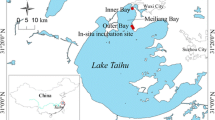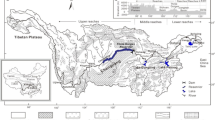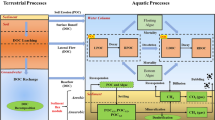Abstract
Blue-green algae (CyanoHABs), photosynthetic bacteria that create a harmful aquatic environment, have been a trending issue on Taihu for over a decade. CyanoHABs adapt to varying climatic changes, which explains why the problem on Taihu still thrives. One major drive that keeps the algae is Sediment Oxygen Demand (SOD). In this paper, seasonal and spatial variations of SOD that contribute immensely to nutrient growth in Lake Taihu were done using the Environmental Fluid Dynamics Code (EFDC). The results were analyzed based on Nitrogenous SOD (NSOD) and Total SOD (TSOD). Summer results ranged from − 0.05754 to − 0.0826 (− 0.75658 to − 0.83902) (g/m2/day) and Winter values ranged from − 0.3022 to − 0.40171 (− 1.34486 to − 1.48856) (g/m2/day) indicate a gradual decrease in NSOD (TSOD) values respectively. Relatively higher values in summer are attributed to warmer surface water which sets up thermal stratification to increase the internal loading of nitrogen. Lower winter values are related to inverse stratification, where lower oxygen concentration decreases the SOD to trigger ammonium accumulation in the water column. NSOD (TSOD) values for Autumn results ranged from − 0.1039 to − 0.24786 (− 0.96251 to − 1.39454) (g/m2/day) and Spring values of − 0.43019 to − 0.35959 (− 1.48297 to − 0.54089) (g/m2/day). Transition seasons (i.e., Autumn and Spring) results are impacted by wind mixing that allows dissolved oxygen and nutrients in the whole water column. However, spring values depict a gradual increase in SOD value attributed to spring turnover and gradual stratification, which decrease nutrient concentration. In contrast, decreasing SOD values in autumn are related to mixing, but temperature decreases tend to increase nutrient concentrations. Carbonaceous sediment oxygen demand (CSOD), due to sulfide oxidation, presents high values from the difference between TSOD and NSOD. Based on the high values of CSOD, it is highly recommended that more research on eutrophic Taihu lakes would consider delving into CSOD.











Similar content being viewed by others
Data availability
Available upon request to the corresponding author.
References
Akomeah E, Lindenschmidt K-E (2017) Seasonal variation in sediment oxygen demand in a northern chained river-lake system. Water 9(4). https://doi.org/10.3390/w9040254
Anderson DM, Glibert PM, Burkholder JM (2002) Harmful algal blooms and eutrophication: nutrient sources, composition, and consequences. Estuaries 25(4):704–726. https://doi.org/10.1007/BF02804901
Bai J, Zhao J, Zhang Z, Tian Z (2022) Assessment and a review of research on surface water quality modeling. Ecol Model 466:109888. https://doi.org/10.1016/j.ecolmodel.2022.109888
Bocaniov SA, Lamb KG, Liu W, Rao YR, Smith REH (2020) High sensitivity of lake hypoxia to air temperatures, winds and nutrient loading: insights from a 3D lake model. Water Resour Res. https://doi.org/10.1029/2019wr027040
Brooks BW, Lazorchak JM, Howard MDA, Johnson M-VV, Morton SL, Perkins DAK, Reavie ED, Scott GI, Smith SA, Steevens JA (2016) Are harmful algal blooms becoming the greatest inland water quality threat to public health and aquatic ecosystems? Environ Toxicol Chem 35(1):6e13. https://doi.org/10.1002/etc.3220
Butts TA (1974) Measurements of sediment oxygen demand characteristics of the upper Illinois waterway
Chen W-B (2012) Measurement of sediment oxygen demand for modeling the dissolved oxygen distribution in a subalpine lake. Int J Phys Sci 7:5036–5048
Chen M, Zeng W, Wang G, Lu F, Zhang J, Ding J (2020) Study on the operation effect of constructed wetland project for tailwater treatment—an example from a sewage plant in Zhejiang province. E3s Web Conf 194(3):04030. https://doi.org/10.1051/e3sconf/202019404030
Cheng Y, Li Y, Wang Y, Tang C, Shi Y, Sarpong L, Li R, Acharya K, Li J (2022) Uncertainty and sensitivity analysis of spatial distributed roughness to a hydrodynamic water quality model: a case study on Lake Taihu, China. Environ Sci Pollut Res 29(9):13688–13699. https://doi.org/10.1007/s11356-021-16623-2
Chengxin FAN (2015) Progress and prospect in formation of black bloom in Lake Taihu: a review. J Lake Sci 27:553–566. https://doi.org/10.18307/2015.0401
Claudia VL, Cuevas Clemente R, Bejarano Franklin T, Cisneros-Pérez R, Cisneros-Almazán R, Couder-Castañeda C (2021) Applying EFDC explorer model in the Gallinas River, Mexico to estimate its assimilation capacity for water quality protection [J]. Scientific Rep 11(1):13023. https://doi.org/10.1038/S41598-021-92453-Z
Di Toro DM (2001) Sediment flux modeling. Wiley-Interscience
Di Toro D, Fitzpatrick J (1993) Chesapeake Bay sediment flux model
Di Toro DM, Paquin PR, Subburamu K, Gruber DA (1990) Sediment oxygen demand model: methane and ammonia oxidation. J Environ Eng ASCE 116:945–986
Duan H, Ma R, Xu X, Kong F, Zhang S, Kong W, Hao J, Shang L (2009) Two-decade reconstruction of algal blooms in China’s lake Taihu. Environ Sci Technol 43(10):3522e3528. https://doi.org/10.1021/es8031852
Duan L, Song J, Liang X, Yin M, Yuan H, Li X (2019) Dynamics and diagenesis of trace metals in sediments of the Changjiang estuary. Sci Total Environ 675:247–259
Hamrick JM (1992) A three-dimensional environmental fluid dynamics computer code: theoretical and computational Aspects. (Special Report No. 317 in Applied Marine Science and Ocean Engineering, Issue
Hamrick JM (1996) User manual for the environmental fluid dynamics computer code: theoretical and computational aspects. Special Report on Marine Science and Ocean Engineering (Publication Number 331) The College of William and Mary]. Virginia
Hamrick JM (2007a) The Environmental Fluid Dynamics Code. US EPA
Hamrick JM (2007b) The Environmental Fluid Dynamics Code. US EPA
Hu WF, Lo W, Chua H, Sin SN, Yu PHF (2001) Nutrient release and sediment oxygen demand in a eutrophic land-locked embayment in Hong Kong. Environ Int 26(5):369–375. https://doi.org/10.1016/S0160-4120(01)00014-9
Huang J, Qi L, Gao J, Kim D-K (2017) Risk assessment of hazardous materials loading into four large lakes in China: a new hydrodynamic indicator based on EFDC. Ecol Indicators 80:23–30. https://doi.org/10.1016/j.ecolind.2017.04.051
Hwang S, Jun S-M, Song J-H, Kim K, Kim H, Kang M-S (2021) Application of the SWAT-EFDC linkage model for assessing water quality management in an estuarine reservoir separated by levees. Appl Sci 11(9):3911. https://doi.org/10.3390/app11093911
Jabbari A, Ackerman JD, Boegman L, Zhao Y (2019) Episodic hypoxia in the western basin of Lake Erie. Limnol Oceanogr. https://doi.org/10.1002/lno.11180
Janssen ABG, de Jager VCL, Janse JH, Kong X, Liu S, Ye Q, Mooij WM (2017) Spatial identification of critical nutrient loads of large shallow lakes: implications for Lake Taihu (China). Water Res 119:276–287. https://doi.org/10.1016/j.watres.2017.04.045
Jiang L, Li Y, Zhao X, Tillotson MR, Wang W, Zhang S, Sarpong L, Asmaa Q, Pan B (2018) Parameter uncertainty and sensitivity analysis of water quality model in Lake Taihu, China. Ecol Model 375:1–12. https://doi.org/10.1016/j.ecolmodel.2018.02.014
Kimambo ON, Gumbo JR, Chikoore H (2019) The occurrence of cyanobacteria blooms in freshwater ecosystems and their link with hydro-meteorological and environmental variations in Tanzania. Heliyon 5(3):e01312–e01312. https://doi.org/10.1016/j.heliyon.2019.e01312
Li Y, Tang C, Zhu J, Pan B, Anim DO, Ji Y, Yu Z, Acharya K (2015) Parametric uncertainty and sensitivity analysis of hydrodynamic processes for a large shallow freshwater lake. Hydrol Sci J 60(6):1078–1095. https://doi.org/10.1080/02626667.2014.948444
Lu G-H, Ma Q, Zhang J-H (2011) Analysis of black water aggregation in Taihu Lake. Water Sci Eng 4(4):374–385. https://doi.org/10.3882/j.issn.1674-2370.2011.04.002
Mao J, Jiang D, Dai H (2015) Spatial–temporal hydrodynamic and algal bloom modelling analysis of a reservoir tributary embayment. J Hydro-Environ Res 9(2):200–215. https://doi.org/10.1016/j.jher.2014.09.005
Molot LA, Watson SB, Creed IF, Trick CG, McCabe SK, Verschoor MJ, Sorichetti C, Powe J, Schiff SL (2014) A novel model for cyanobacteria bloom formation: the critical role of anoxia and ferrous iron. Freshw Biol 59(6):1323–1340. https://doi.org/10.1111/fwb.12334
Moore TN, Cuker BE (2018) Sedimentary oxygen demand and orthophosphate release: sustaining eutrophication in a tributary of the Chesapeake Bay. J Water Resour Ocean Sci 7(3):42–48. https://doi.org/10.11648/j.wros.20180703.13
Noori R, Berndtsson R, Franklin Adamowski J, RabieeAbyaneh M (2018) Temporal and depth variation of water quality due to thermal stratification in Karkheh Reservoir, Iran. J Hydrol: Reg Stud 19:279–286. https://doi.org/10.1016/j.ejrh.2018.10.003
Noori R, Asadi N, Deng Z (2019a) A simple model for simulation of reservoir stratification. J Hydraul Res 57(4):561–572. https://doi.org/10.1080/00221686.2018.1499052
Noori R, Tian F, Ni G, Bhattarai R, Hooshyaripor F, Klöve B (2019b) ThSSim: a novel tool for simulation of reservoir thermal stratification. Sci Rep 9:18524
Noori R, Ansari E, Bhattarai R, Tang Q, Aradpour S, Maghrebi M, TorabiHaghighi A, Bengtsson L, Kløve B (2021a) Complex dynamics of water quality mixing in a warm mono-mictic reservoir. Sci Total Environ 777:146097. https://doi.org/10.1016/j.scitotenv.2021.146097
Noori R, Ansari E, Jeong Y-W, Aradpour S, Maghrebi M, Hosseinzadeh M, Bateni SM (2021b) Hyper-nutrient enrichment status in the Sabalan Lake, Iran. Water 13(20):2874. https://www.mdpi.com/2073-4441/13/20/2874
Nwankwegu AS, Li Y, Huang Y, Wei J, Norgbey E, Sarpong L, Lai Q, Wang K (2019) Harmful algal blooms under changing climate and constantly increasing anthropogenic actions: the review of management implications. 3 Biotech 9(12):449. https://doi.org/10.1007/s13205-019-1976-1
Paraska DW, Hipsey MR, Salmon SU (2014) Sediment diagenesis models: review of approaches, challenges and opportunities. Environ Model Softw 61:297–325. https://doi.org/10.1016/j.envsoft.2014.05.011
Pyo J, Kwon YS, Min JH, Nam G, Song YS, Ahn JM (2021) Effectof hyperspectral image-based initial conditions on improving short-term algal simulation of hydrodynamic and water quality models. J Environ Manage 294:112988. https://doi.org/10.1016/j.jenvman.2021.112988
Qin B, Xu P, Wu Q, Luo L, Zhang Y (2007) Environmental issues of Lake Taihu, China. In: Qin B, Liu Z, Havens K (eds) Eutrophication of shallow lakes with special reference to Lake Taihu, China. Springer, Netherlands, pp 3–14. https://doi.org/10.1007/978-1-4020-6158-5_2
Qin B, Zhu G, Gao G, Zhang Y, Li W, Paerl HW, Carmichael WW (2010) A drinking water crisis in Lake Taihu, China: linkage to climatic variability and lake management. Environ Manage 45(1):105–112. https://doi.org/10.1007/s00267-009-9393-6
Qin B-Q, Paerl H, Brookes J, Liu J, Jeppesen E, Zhu G, Zhang Y, Xu H, Shi K, Deng J (2019) Why Lake Taihu continues to be plagued with cyanobacterial blooms through 10 years (2007-2017) efforts. Sci Bull 64. https://doi.org/10.1016/j.scib.2019.02.008
Rong N, Shan B, Wang C (2016) Determination of sediment oxygen demand in the Ziya River Watershed, China: based on laboratory core incubation and microelectrode measurements. Int J Environ Res Public Health 13(2):232. https://www.mdpi.com/1660-4601/13/2/232. Accessed 20 Oct 2022
Sarpong L, Li Y, Norgbey E, Nwankwegu AS, Cheng Y, Nasiru S, Nooni IK, Setordjie VE (2020) A sediment diagenesis model of seasonal nitrate and ammonium flux spatial variation contributing to eutrophication at Taihu, China. Int J Environ Res Public Health 17(11):4158. https://www.mdpi.com/1660-4601/17/11/4158. Accessed 12 May 2022
Scavia D, David Allan J, Arend KK, Bartell S, Beletsky D, Bosch NS, Brandt SB, Briland RD, Daloğlu I, DePinto JV, Dolan DM, Evans MA, Farmer TM, Goto D, Han H, Höök TO, Knight R, Ludsin SA, Mason D, Michalak AM, Peter Richards R, Roberts JJ, Rucinski DK, Rutherford E, Schwab DJ, Sesterhenn TM, Zhang H, Zhou Y (2014) Assessing and addressing the re-eutrophication of Lake Erie: central basin hypoxia. J Great Lakes Res 40(2):226–246. https://doi.org/10.1016/j.jglr.2014.02.004
Steinsberger T, Müller B, Gerber C, Shafei B, Schmid M (2019) Modeling sediment oxygen demand in a highly productive lake under various trophic scenarios. PLoS One 14(10):e0222318. https://doi.org/10.1371/journal.pone.0222318
Terry JA, Sadeghian A, Lindenschmidt K-E (2017) Modelling dissolved oxygen/sediment oxygen demand under ice in a shallow eutrophic prairie reservoir. Water 9(2):131. https://www.mdpi.com/2073-4441/9/2/131. Accessed 12 May 2022
Walker RR, Snodgrass WJ (1986) Model for sediment oxygen demand in lakes. J Environ Eng 112(1):25–43. https://doi.org/10.1061/(asce)0733-9372(1986)112:1(25)
Wu T, Qin B, Brookes JD, Shi K, Zhu G, Zhu M, Yan W, Wang Z (2015) The influence of changes in wind patterns on the areal extension of surface cyanobacterial blooms in a large shallow lake in China. Sci Total Environ 518–519:24–30. https://doi.org/10.1016/j.scitotenv.2015.02.090
Wu T, Qin B, Brookes JD, Yan W, Ji X, Feng J (2019) Spatial distribution of sediment nitrogen and phosphorus in Lake Taihu from a hydrodynamics-induced transport perspective. Sci Total Environ 650:1554–1565. https://doi.org/10.1016/j.scitotenv.2018.09.145
Yamaguchi KE, Oguri K, Ogawa NO, Sakai S, Hirano S, Kitazato H, Ohkouchi N (2010) Geochemistry of modern carbonaceous sediments overlain by a water mass showing photic zone anoxia in the saline meromictic Lake Kai-ike, southwest Japan: I. Early diagenesis of organic carbon, nitrogen, and phosphorus. Palaeogeography, Palaeoclimatology, Palaeoecology 294(1):72–82. https://doi.org/10.1016/j.palaeo.2009.10.024
Zhang Y, Qin B, Zhu G, Gao G, Luo L, Chen W (2006) Effect of sediment resuspension on underwater light field in shallow lakes in the middle and lower reaches of the Yangtze River: a case study in Longgan Lake and Taihu Lake. Sci China Ser D 49(1):114–125. https://doi.org/10.1007/s11430-006-8111-y
Zhang Z, Sun B, Johnson BE (2015) Integration of a benthic sediment diagenesis module into the two dimensional hydrodynamic and water quality model—CE-QUAL-W2. Ecol Model 297:213–231. https://doi.org/10.1016/j.ecolmodel.2014.10.025
Zhang J, Wu Y, Tian Z, Chu Z, Yuan J, Hou Z (2020) Temperature simulation of Erhai Lake based on EFDC model. J Environ Eng Tech 10(3):368–376. https://doi.org/10.12153/j.issn.1674-991X.20190197
Zhao Q, Wei Y, Ouyang X (2013) Spatial distribution of penetration depth in Taihu Lake (China) during spring and autumn. Chin J Oceanol Limnol 31(4):907–916. https://doi.org/10.1007/s00343-013-2284-y
Acknowledgements
Appreciation goes to the all-team members who have been completely assertive and consistent in this work.
Funding
This work was supported by the Chinese National Science Foundation (Nos. 51579071 and. 51379061), the National Science Funds for Creative Research Groups of China (No. 51421006), the Innovative Research Team in Jiangsu Province, and a project funded by the Priority Academic Program Development of Jiangsu Higher Education Institutions.
Author information
Authors and Affiliations
Contributions
Y.L. and L.S conceived, designed the study and performed formal analysis, validated the results, and wrote the manuscript; Y.C. E.N, I.K.N, M.D., S.N., V.E.S., and R.A.B.D. for data curation, visualization, and formal analysis; reviewed and edited.
Corresponding author
Ethics declarations
Ethical approval
Not applicable.
Consent to participate
Not applicable.
Consent for publication
Not applicable.
Competing interests
The authors declare no competing interests.
Additional information
Responsible Editor: Marcus Schulz
Publisher's note
Springer Nature remains neutral with regard to jurisdictional claims in published maps and institutional affiliations.
Rights and permissions
Springer Nature or its licensor (e.g. a society or other partner) holds exclusive rights to this article under a publishing agreement with the author(s) or other rightsholder(s); author self-archiving of the accepted manuscript version of this article is solely governed by the terms of such publishing agreement and applicable law.
About this article
Cite this article
Li, Y., Sarpong, L., Cheng, Y. et al. A sediment diagenesis model on sediment oxygen demand in managing eutrophication on Taihu, China. Environ Sci Pollut Res 30, 35602–35616 (2023). https://doi.org/10.1007/s11356-022-24301-0
Received:
Accepted:
Published:
Issue Date:
DOI: https://doi.org/10.1007/s11356-022-24301-0




